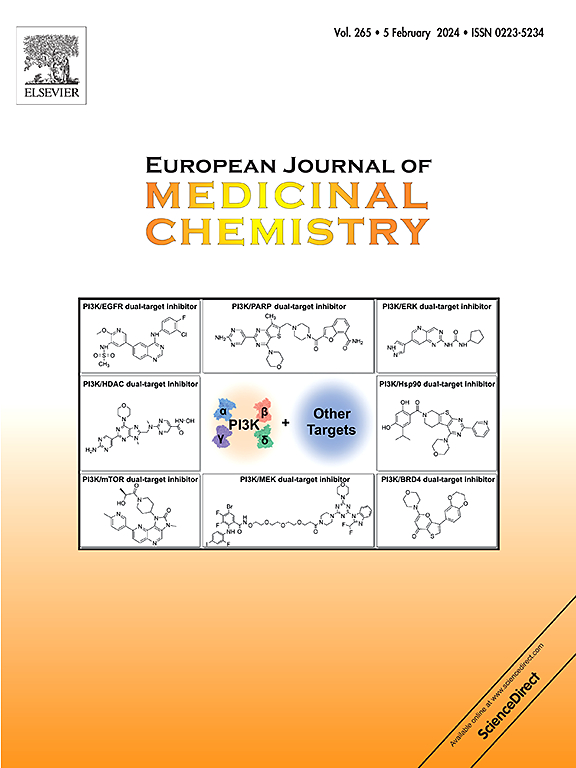通过阻断hsp90 - cdc37 -激酶周期,在体外和体内发现新的具有抗肿瘤活性的celastrol衍生物
IF 6
2区 医学
Q1 CHEMISTRY, MEDICINAL
引用次数: 0
摘要
hsp90 - cdc37激酶周期在癌症的发展中起着关键作用。而Cdc37(丝氨酸13)被CK2磷酸化是一个先决条件。Celastrol (CEL)通过抑制Hsp90-Cdc37蛋白-蛋白相互作用(PPI)干扰Hsp90-Cdc37激酶周期,发挥抗肿瘤作用。本研究首先将CK2抑制剂的药效团引入到CEL中,得到18个衍生物,以提高其抗肿瘤活性,并对衍生物的抗增殖能力进行了评价。其中化合物11对MDA-MB-231活性最强(IC50 = 0.25±0.02 μM),约为CEL的7倍。此外,11不仅选择性地抑制CK2活性,还能破坏Hsp90-Cdc37 PPI,从而导致激酶客户水平急剧下降,从而阻滞细胞周期,诱导细胞凋亡。11的体内肿瘤抑制率(65.3%)明显高于CEL(38.0%),且无明显毒性。综上所述,化合物11可以更有效地阻断hsp90 - cdc37 -激酶周期,这可能是一个有希望的抗肿瘤候选药物。本文章由计算机程序翻译,如有差异,请以英文原文为准。


Discovery of new celastrol derivatives with antitumor activity in vitro and in vivo by blocking Hsp90-Cdc37-kinase cycle
Hsp90-Cdc37-kinase cycle plays a critical role in the development of cancers. And the phosphorylation of Cdc37 (Serine13) by CK2 is a prerequisite. Celastrol (CEL) can interfere with Hsp90-Cdc37-kinase cycle by inhibiting Hsp90-Cdc37 protein-protein interaction (PPI) to exhibit antitumor effect. In this study, the pharmacophore of CK2 inhibitors was first introduced to CEL to obtain 18 derivatives to improve the antitumor activity, and the anti-proliferation of the derivatives was evaluated. Among them, compound 11 exhibited the most potent activity against MDA-MB-231 (IC50 = 0.25 ± 0.02 μM) which was about 7 times that of CEL. Furthermore, 11 not only selectively inhibited CK2 activity, but also disrupted Hsp90-Cdc37 PPI, thereby leading to a sharp decrease on the level of kinase clients to arrest cell cycle and induce apoptosis. Moreover, 11 showed much higher tumor inhibition rate (65.3 %) than CEL (38.0 %) in vivo without obvious toxicity. Taken together, compound 11 could more effectively block Hsp90-Cdc37-kinase cycle, which might be a promising antitumor candidate.
求助全文
通过发布文献求助,成功后即可免费获取论文全文。
去求助
来源期刊
CiteScore
11.70
自引率
9.00%
发文量
863
审稿时长
29 days
期刊介绍:
The European Journal of Medicinal Chemistry is a global journal that publishes studies on all aspects of medicinal chemistry. It provides a medium for publication of original papers and also welcomes critical review papers.
A typical paper would report on the organic synthesis, characterization and pharmacological evaluation of compounds. Other topics of interest are drug design, QSAR, molecular modeling, drug-receptor interactions, molecular aspects of drug metabolism, prodrug synthesis and drug targeting. The journal expects manuscripts to present the rational for a study, provide insight into the design of compounds or understanding of mechanism, or clarify the targets.

 求助内容:
求助内容: 应助结果提醒方式:
应助结果提醒方式:


